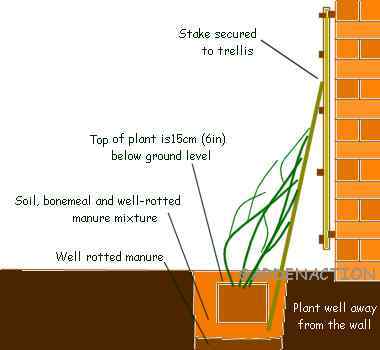Clematis
CLEMATIS

Clematis is undoubtedly the Queen of climbers! ?Clematis grows beautifully on its own or planted among perennials, with trees and shrubs, roses, and other vines.
Where to plant:
Clematis prefers a soil rich in organic matter that is well drained yet retains moisture. ?Clematis use lots of water all season. ?Drought is the number one cause of transplant failure! ?Avoid planting them under the eves of buildings, as it is too dry. ?Clematis prefer full sun conditions, although some will tolerate part shade. ?Sites protected from strong winds are best.
What to climb on:
Clematis have twining tendrils that they use to grow up supports. ?You must provide a strong trellis or wires and tie them to the support initially, until they climb on their own.
Regularly check that any ties you used are not too tight. ?As the plant develops its stems will thicken, and ties that are too tight may cut into the stems and restrict growth.
To train clematis up a brick wall, you can screw 'vine eyes' into brickwork, mortar, or masonry, and then thread wire between them and pull tight. ?It is a good idea to plan out where the plant will be trained early on, and construct the support at this stage.
Clematis can be trained to climb on any screen, pergola, arch, or obelisk.
Clematis looks great growing up a large shrub, the trunk of a healthy tree, or used to cover the trunk of a dead tree that is hard to remove. ?Just make sure that the vine will get enough sunlight.
When to plant:
The best time to plant is spring or autumn, but all container grown plants can be planted at any time. ?Clematis planted in the summer will need regular watering as the plant will be in full growth and the roots will not be fully established.
How to plant:
Before planting, thoroughly soak the plant in a bucket of water. ?Dig a hole, at least twice as wide as the pot in which the plant is growing and half as deep again.
Carefully remove the plant with its cane support from the container and gently tease out some of the roots and place in the hole. ?Large flowered cultivars should be planted with two leaf notes, or 3-6" below soil level. ?Planting this deep will encourage the plant to become multi-stemmed. ?Species of clematis, which have thin fibrous root systems, do not need to be planted deeply. ?Back-fill with a mixture of soil and compost. ?Mulch and water in well. ?Keep the new plant well watered, but not soggy until it is established. ?Keep it weeded and maintain a light mulch over the soil.
When planting next to shrubs or trees, place the hole outside the rain shadow and use the canes to train the plant into the shrub/tree.
When planting next to a wall, place hole at least 2 feet from the wall and train plant along the cane towards the wall. ?In both these cases particular attention should be paid to regular watering until well established.

?
Clematis like cool feet!
While clematis like their heads in the sun, they like their roots to be shaded and cool. ?So be sure to use a thick mulch or plant a low growing shallow rooted annual or perennial at the base.
How to fertilize:
You can fertilize with manure tea or a water-soluble fertilizer right after planting. ?Do not use fresh manure or a fertilizer high in nitrogen. ?To help your flowering vine achieve its maximum potential and blanket itself with generous blooms fertilize it with a balanced fertilizer once a year during the growing season. ?Put the fertilizer right on top of the mulch, no closer than 2-3 inches from the stems, to avoid burning. ?Be sure to water it in well. ?You can fertilize in the spring when they are starting to leaf out, at the same time as roses.

How to prune:
It is recommended that all newly planted clematis should be pruned to 6-10 inches either immediately after planting or sometime during the first year. ?This will encourage the plant to become multi-stemmed, bushy and incrase the number of flowers.
Thereafter prune according to the Pruning Group:
Group 1:?These include alpinas and macropelatas. ?Pruning is not required, but they are often pruned after flowering to reduce size, or to encourage branching.
Group 2:?This group glowers on the last season's wood in late spring, then maller blossoms on new wood during the summer. ?In early spring, prune back dead wood until green wood is encountered in the stem. ?Leave all live wood. ?If some thinning is necessary on older plants, do so immediately after the early blooms are done. ?Varieties include Blue Light, Henryi, and Violet Charm.
Group 3:?This group flowers during the summer on new wood only. ?These should be pruned 8" from the ground in very early spring. ?Varieties include Bee's Jubilee, Jackmanii, Earnest Markham, and Pink Fantasy.

